Environmental Impacts of Public Transit in Vancouver, Canada
VerifiedAdded on 2022/08/09
|8
|1747
|19
Essay
AI Summary
This essay examines the public transit system in Vancouver, Canada, focusing on its environmental impacts. It begins by outlining the city's increasing population and the subsequent rise in vehicle use, leading to traffic congestion and pollution. The essay then describes Vancouver's public transit system, managed by Translink, including buses, SeaBus, and SkyTrain, highlighting its eco-friendly nature. It explores the environmental consequences of traffic congestion, such as air and marine pollution, and identifies problems in the current system, including heavy traffic and limited road space. The essay proposes solutions like introducing green vehicles, promoting cycling, and encouraging public transit use to reduce pollution and improve traffic management. The conclusion emphasizes the need for government awareness campaigns, better traffic management, and the construction of new infrastructure to address the environmental issues related to transportation in Vancouver.
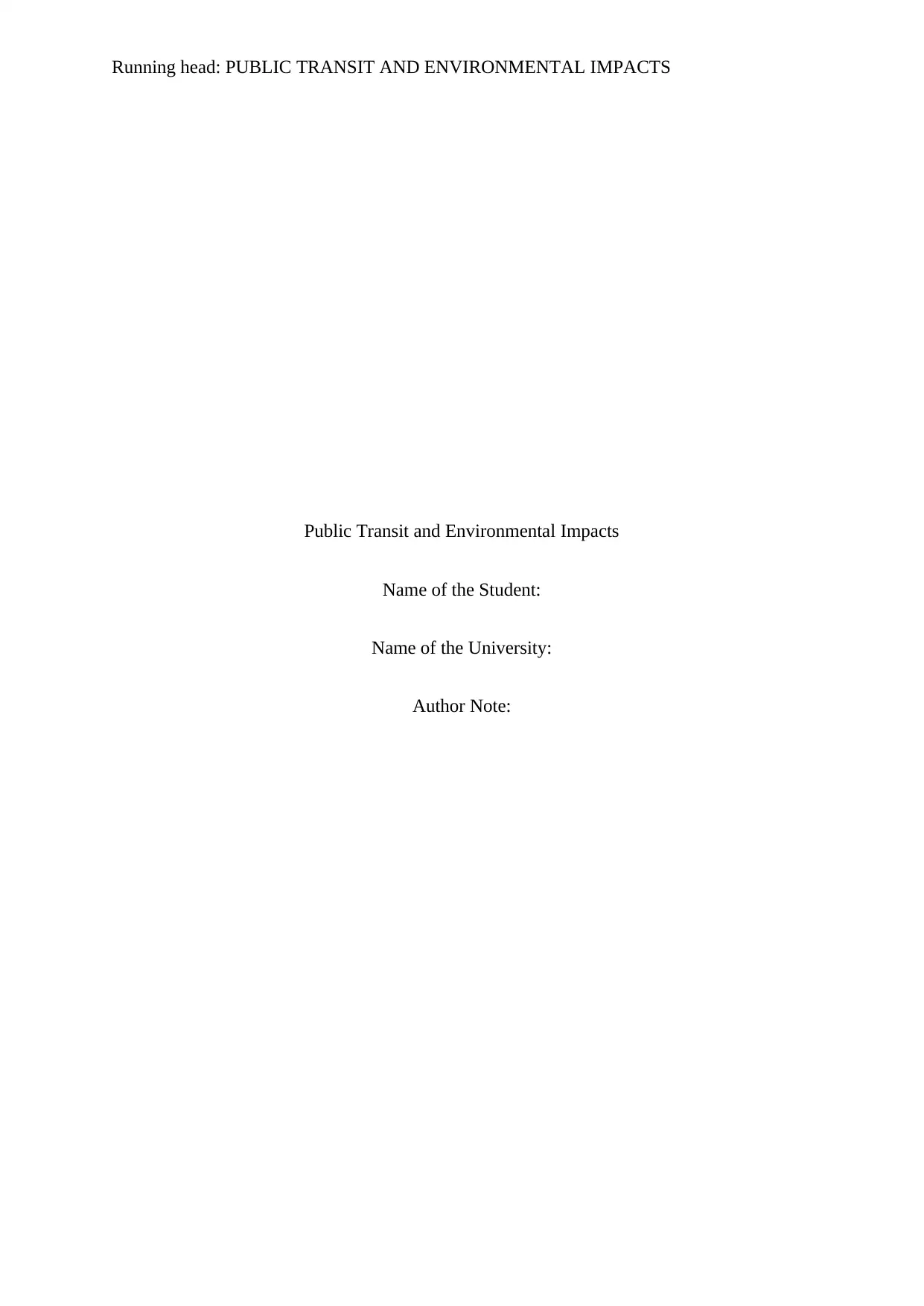
Running head: PUBLIC TRANSIT AND ENVIRONMENTAL IMPACTS
Public Transit and Environmental Impacts
Name of the Student:
Name of the University:
Author Note:
Public Transit and Environmental Impacts
Name of the Student:
Name of the University:
Author Note:
Paraphrase This Document
Need a fresh take? Get an instant paraphrase of this document with our AI Paraphraser
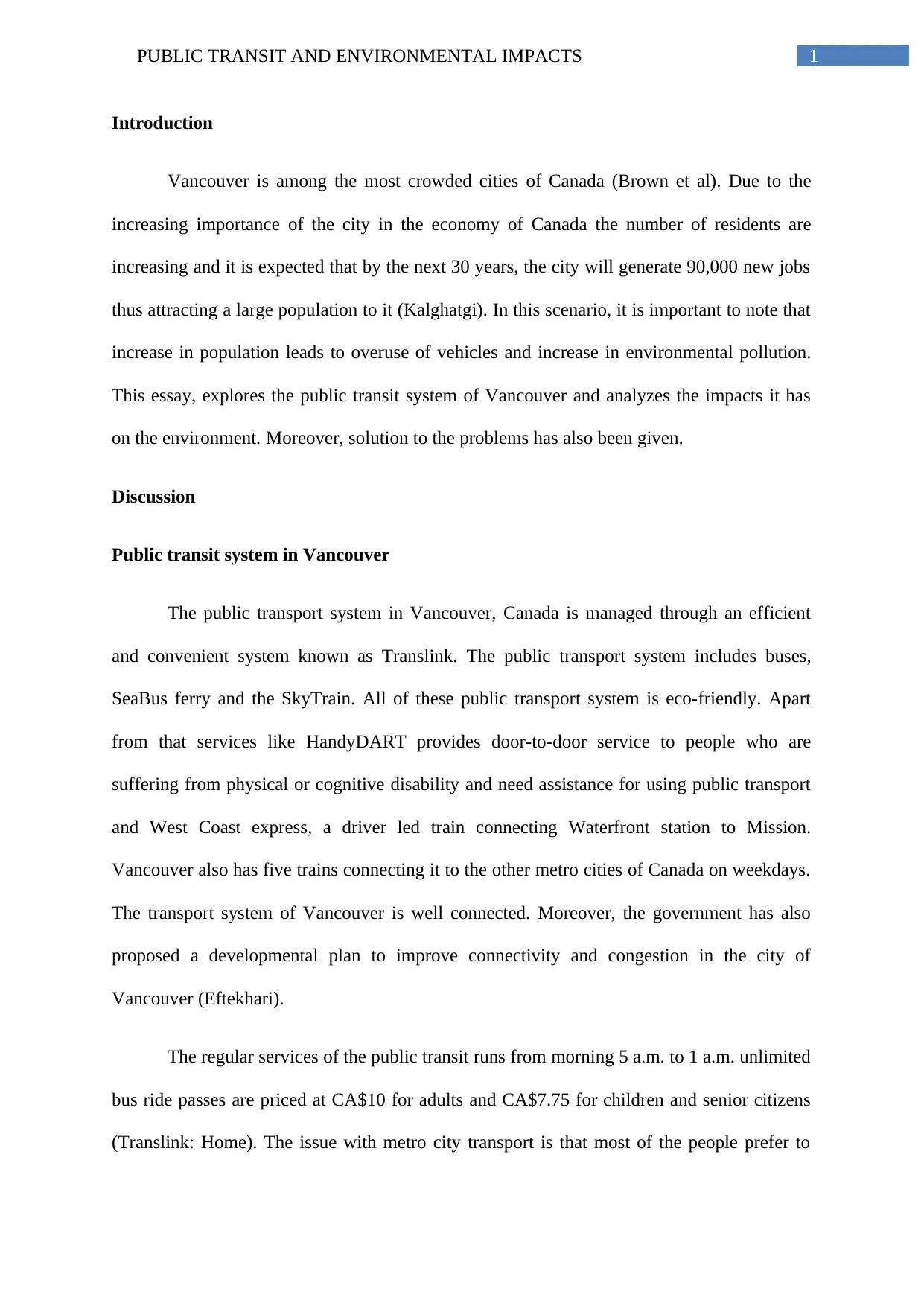
1PUBLIC TRANSIT AND ENVIRONMENTAL IMPACTS
Introduction
Vancouver is among the most crowded cities of Canada (Brown et al). Due to the
increasing importance of the city in the economy of Canada the number of residents are
increasing and it is expected that by the next 30 years, the city will generate 90,000 new jobs
thus attracting a large population to it (Kalghatgi). In this scenario, it is important to note that
increase in population leads to overuse of vehicles and increase in environmental pollution.
This essay, explores the public transit system of Vancouver and analyzes the impacts it has
on the environment. Moreover, solution to the problems has also been given.
Discussion
Public transit system in Vancouver
The public transport system in Vancouver, Canada is managed through an efficient
and convenient system known as Translink. The public transport system includes buses,
SeaBus ferry and the SkyTrain. All of these public transport system is eco-friendly. Apart
from that services like HandyDART provides door-to-door service to people who are
suffering from physical or cognitive disability and need assistance for using public transport
and West Coast express, a driver led train connecting Waterfront station to Mission.
Vancouver also has five trains connecting it to the other metro cities of Canada on weekdays.
The transport system of Vancouver is well connected. Moreover, the government has also
proposed a developmental plan to improve connectivity and congestion in the city of
Vancouver (Eftekhari).
The regular services of the public transit runs from morning 5 a.m. to 1 a.m. unlimited
bus ride passes are priced at CA$10 for adults and CA$7.75 for children and senior citizens
(Translink: Home). The issue with metro city transport is that most of the people prefer to
Introduction
Vancouver is among the most crowded cities of Canada (Brown et al). Due to the
increasing importance of the city in the economy of Canada the number of residents are
increasing and it is expected that by the next 30 years, the city will generate 90,000 new jobs
thus attracting a large population to it (Kalghatgi). In this scenario, it is important to note that
increase in population leads to overuse of vehicles and increase in environmental pollution.
This essay, explores the public transit system of Vancouver and analyzes the impacts it has
on the environment. Moreover, solution to the problems has also been given.
Discussion
Public transit system in Vancouver
The public transport system in Vancouver, Canada is managed through an efficient
and convenient system known as Translink. The public transport system includes buses,
SeaBus ferry and the SkyTrain. All of these public transport system is eco-friendly. Apart
from that services like HandyDART provides door-to-door service to people who are
suffering from physical or cognitive disability and need assistance for using public transport
and West Coast express, a driver led train connecting Waterfront station to Mission.
Vancouver also has five trains connecting it to the other metro cities of Canada on weekdays.
The transport system of Vancouver is well connected. Moreover, the government has also
proposed a developmental plan to improve connectivity and congestion in the city of
Vancouver (Eftekhari).
The regular services of the public transit runs from morning 5 a.m. to 1 a.m. unlimited
bus ride passes are priced at CA$10 for adults and CA$7.75 for children and senior citizens
(Translink: Home). The issue with metro city transport is that most of the people prefer to
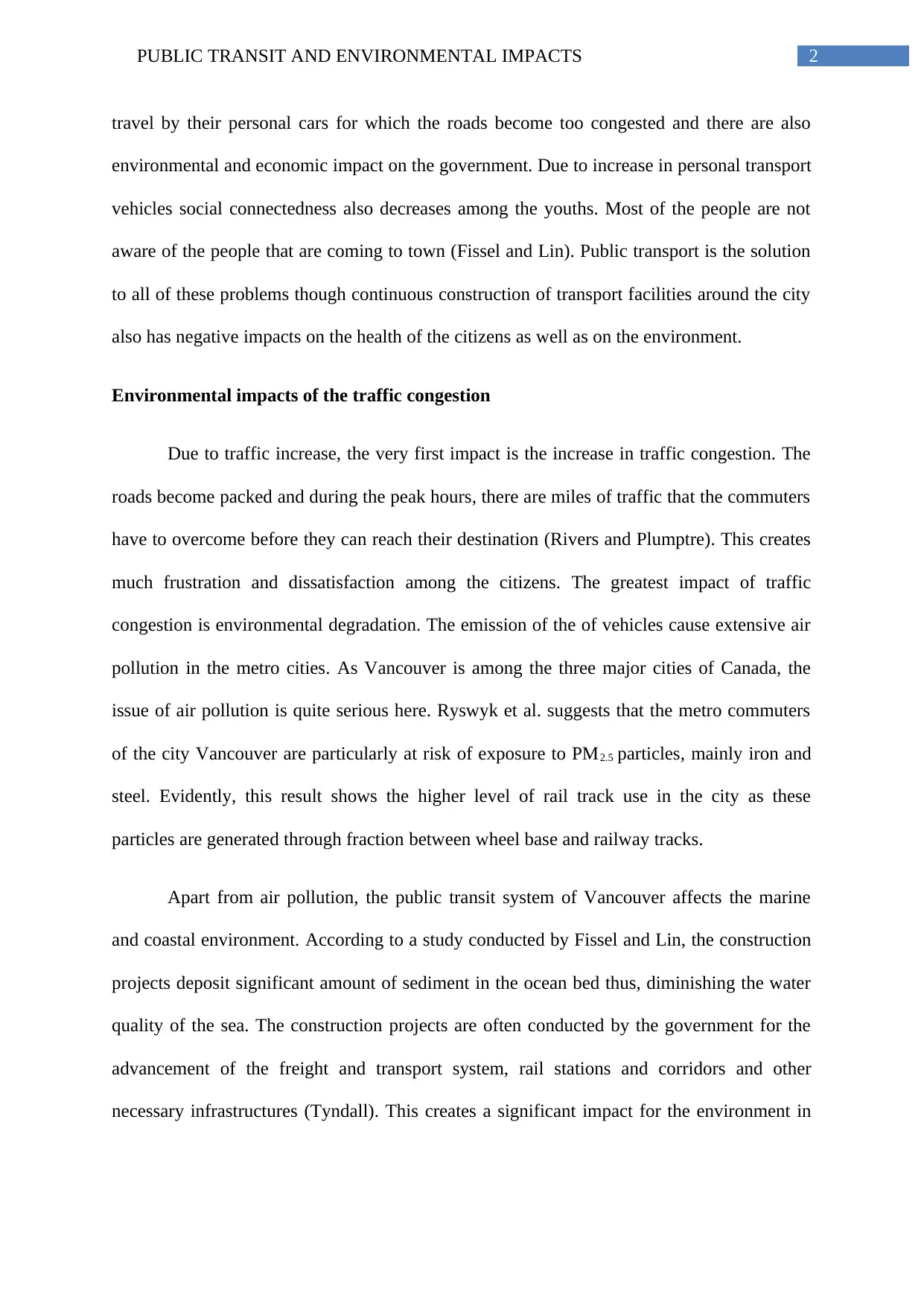
2PUBLIC TRANSIT AND ENVIRONMENTAL IMPACTS
travel by their personal cars for which the roads become too congested and there are also
environmental and economic impact on the government. Due to increase in personal transport
vehicles social connectedness also decreases among the youths. Most of the people are not
aware of the people that are coming to town (Fissel and Lin). Public transport is the solution
to all of these problems though continuous construction of transport facilities around the city
also has negative impacts on the health of the citizens as well as on the environment.
Environmental impacts of the traffic congestion
Due to traffic increase, the very first impact is the increase in traffic congestion. The
roads become packed and during the peak hours, there are miles of traffic that the commuters
have to overcome before they can reach their destination (Rivers and Plumptre). This creates
much frustration and dissatisfaction among the citizens. The greatest impact of traffic
congestion is environmental degradation. The emission of the of vehicles cause extensive air
pollution in the metro cities. As Vancouver is among the three major cities of Canada, the
issue of air pollution is quite serious here. Ryswyk et al. suggests that the metro commuters
of the city Vancouver are particularly at risk of exposure to PM2.5 particles, mainly iron and
steel. Evidently, this result shows the higher level of rail track use in the city as these
particles are generated through fraction between wheel base and railway tracks.
Apart from air pollution, the public transit system of Vancouver affects the marine
and coastal environment. According to a study conducted by Fissel and Lin, the construction
projects deposit significant amount of sediment in the ocean bed thus, diminishing the water
quality of the sea. The construction projects are often conducted by the government for the
advancement of the freight and transport system, rail stations and corridors and other
necessary infrastructures (Tyndall). This creates a significant impact for the environment in
travel by their personal cars for which the roads become too congested and there are also
environmental and economic impact on the government. Due to increase in personal transport
vehicles social connectedness also decreases among the youths. Most of the people are not
aware of the people that are coming to town (Fissel and Lin). Public transport is the solution
to all of these problems though continuous construction of transport facilities around the city
also has negative impacts on the health of the citizens as well as on the environment.
Environmental impacts of the traffic congestion
Due to traffic increase, the very first impact is the increase in traffic congestion. The
roads become packed and during the peak hours, there are miles of traffic that the commuters
have to overcome before they can reach their destination (Rivers and Plumptre). This creates
much frustration and dissatisfaction among the citizens. The greatest impact of traffic
congestion is environmental degradation. The emission of the of vehicles cause extensive air
pollution in the metro cities. As Vancouver is among the three major cities of Canada, the
issue of air pollution is quite serious here. Ryswyk et al. suggests that the metro commuters
of the city Vancouver are particularly at risk of exposure to PM2.5 particles, mainly iron and
steel. Evidently, this result shows the higher level of rail track use in the city as these
particles are generated through fraction between wheel base and railway tracks.
Apart from air pollution, the public transit system of Vancouver affects the marine
and coastal environment. According to a study conducted by Fissel and Lin, the construction
projects deposit significant amount of sediment in the ocean bed thus, diminishing the water
quality of the sea. The construction projects are often conducted by the government for the
advancement of the freight and transport system, rail stations and corridors and other
necessary infrastructures (Tyndall). This creates a significant impact for the environment in
⊘ This is a preview!⊘
Do you want full access?
Subscribe today to unlock all pages.

Trusted by 1+ million students worldwide
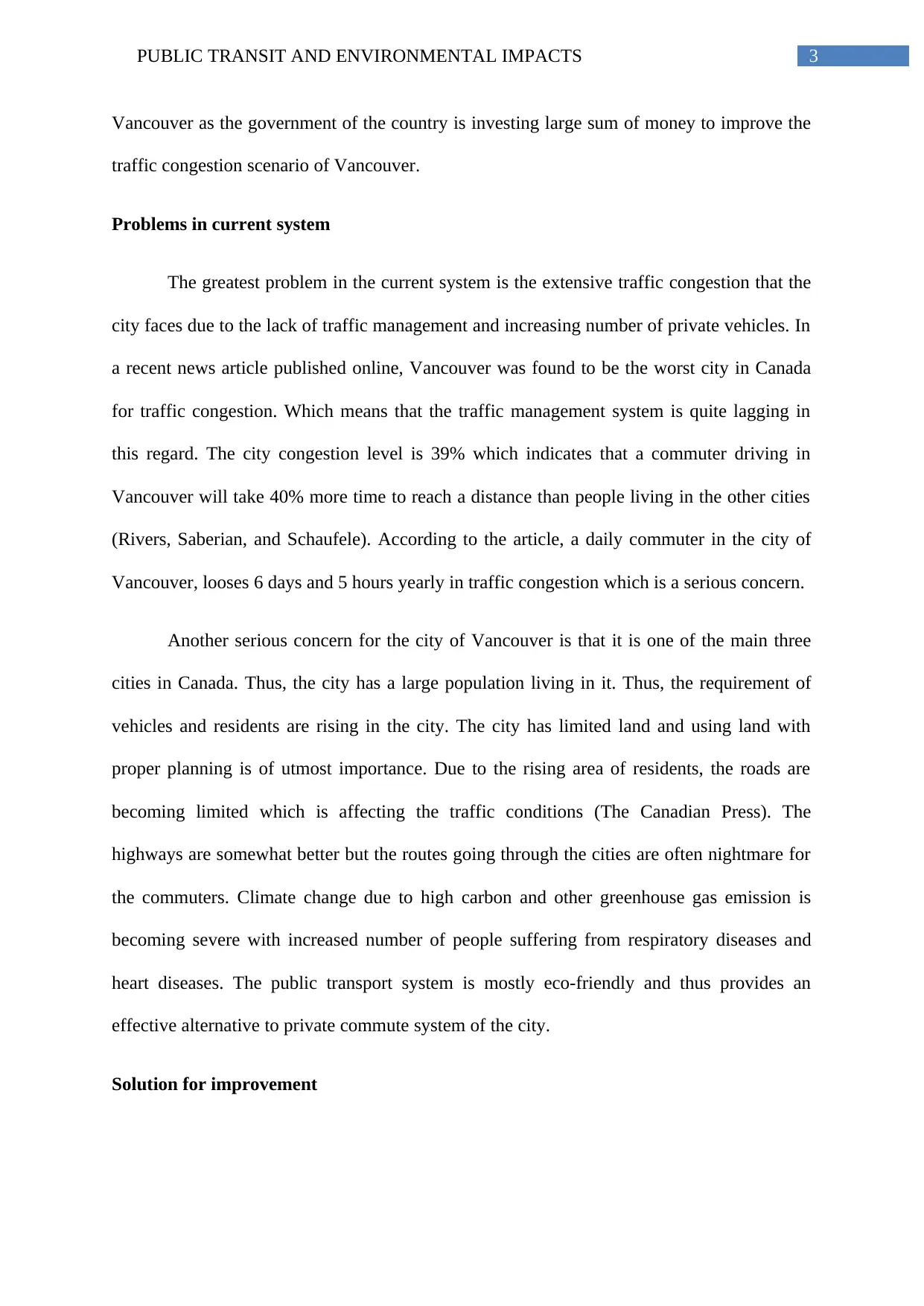
3PUBLIC TRANSIT AND ENVIRONMENTAL IMPACTS
Vancouver as the government of the country is investing large sum of money to improve the
traffic congestion scenario of Vancouver.
Problems in current system
The greatest problem in the current system is the extensive traffic congestion that the
city faces due to the lack of traffic management and increasing number of private vehicles. In
a recent news article published online, Vancouver was found to be the worst city in Canada
for traffic congestion. Which means that the traffic management system is quite lagging in
this regard. The city congestion level is 39% which indicates that a commuter driving in
Vancouver will take 40% more time to reach a distance than people living in the other cities
(Rivers, Saberian, and Schaufele). According to the article, a daily commuter in the city of
Vancouver, looses 6 days and 5 hours yearly in traffic congestion which is a serious concern.
Another serious concern for the city of Vancouver is that it is one of the main three
cities in Canada. Thus, the city has a large population living in it. Thus, the requirement of
vehicles and residents are rising in the city. The city has limited land and using land with
proper planning is of utmost importance. Due to the rising area of residents, the roads are
becoming limited which is affecting the traffic conditions (The Canadian Press). The
highways are somewhat better but the routes going through the cities are often nightmare for
the commuters. Climate change due to high carbon and other greenhouse gas emission is
becoming severe with increased number of people suffering from respiratory diseases and
heart diseases. The public transport system is mostly eco-friendly and thus provides an
effective alternative to private commute system of the city.
Solution for improvement
Vancouver as the government of the country is investing large sum of money to improve the
traffic congestion scenario of Vancouver.
Problems in current system
The greatest problem in the current system is the extensive traffic congestion that the
city faces due to the lack of traffic management and increasing number of private vehicles. In
a recent news article published online, Vancouver was found to be the worst city in Canada
for traffic congestion. Which means that the traffic management system is quite lagging in
this regard. The city congestion level is 39% which indicates that a commuter driving in
Vancouver will take 40% more time to reach a distance than people living in the other cities
(Rivers, Saberian, and Schaufele). According to the article, a daily commuter in the city of
Vancouver, looses 6 days and 5 hours yearly in traffic congestion which is a serious concern.
Another serious concern for the city of Vancouver is that it is one of the main three
cities in Canada. Thus, the city has a large population living in it. Thus, the requirement of
vehicles and residents are rising in the city. The city has limited land and using land with
proper planning is of utmost importance. Due to the rising area of residents, the roads are
becoming limited which is affecting the traffic conditions (The Canadian Press). The
highways are somewhat better but the routes going through the cities are often nightmare for
the commuters. Climate change due to high carbon and other greenhouse gas emission is
becoming severe with increased number of people suffering from respiratory diseases and
heart diseases. The public transport system is mostly eco-friendly and thus provides an
effective alternative to private commute system of the city.
Solution for improvement
Paraphrase This Document
Need a fresh take? Get an instant paraphrase of this document with our AI Paraphraser
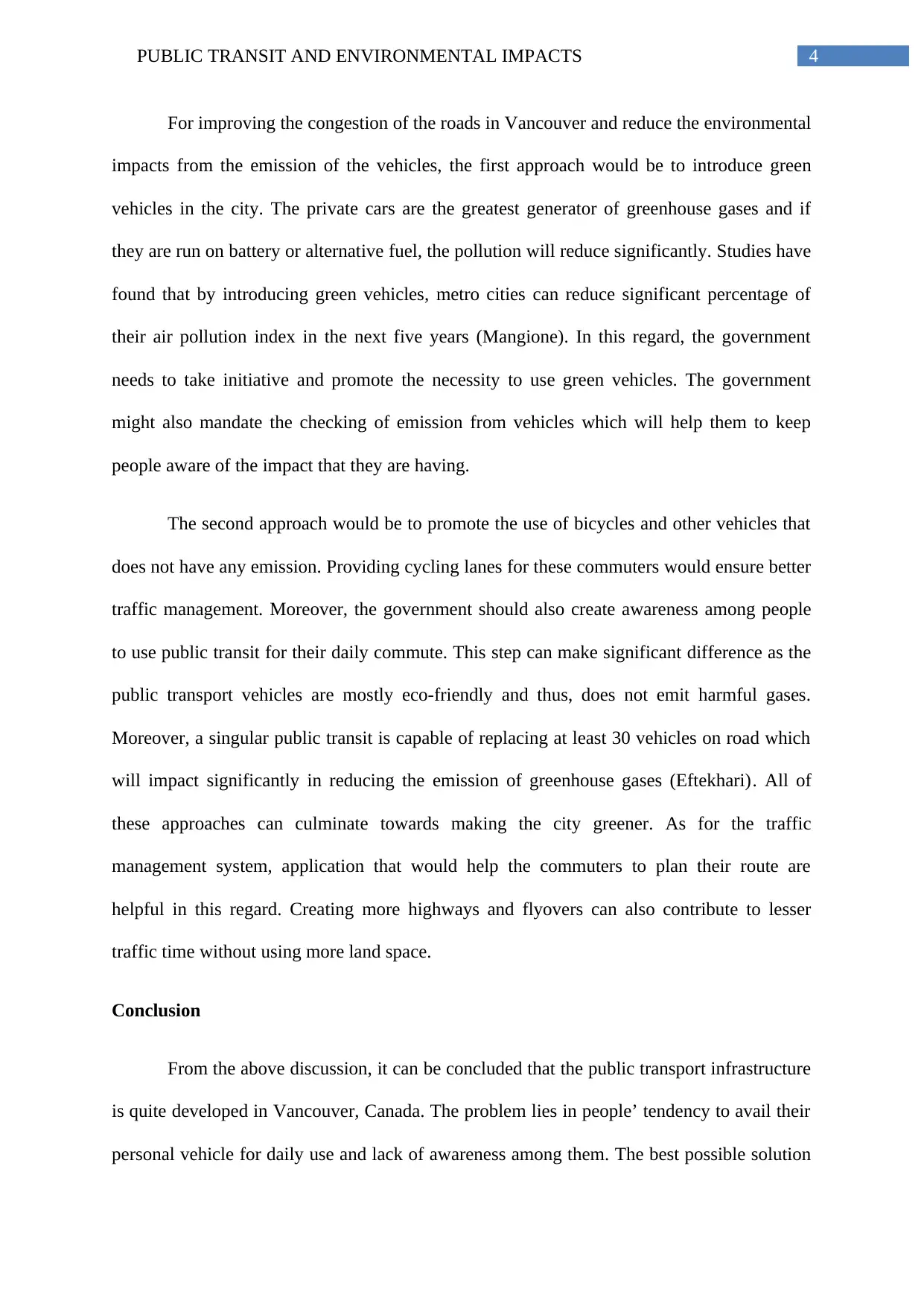
4PUBLIC TRANSIT AND ENVIRONMENTAL IMPACTS
For improving the congestion of the roads in Vancouver and reduce the environmental
impacts from the emission of the vehicles, the first approach would be to introduce green
vehicles in the city. The private cars are the greatest generator of greenhouse gases and if
they are run on battery or alternative fuel, the pollution will reduce significantly. Studies have
found that by introducing green vehicles, metro cities can reduce significant percentage of
their air pollution index in the next five years (Mangione). In this regard, the government
needs to take initiative and promote the necessity to use green vehicles. The government
might also mandate the checking of emission from vehicles which will help them to keep
people aware of the impact that they are having.
The second approach would be to promote the use of bicycles and other vehicles that
does not have any emission. Providing cycling lanes for these commuters would ensure better
traffic management. Moreover, the government should also create awareness among people
to use public transit for their daily commute. This step can make significant difference as the
public transport vehicles are mostly eco-friendly and thus, does not emit harmful gases.
Moreover, a singular public transit is capable of replacing at least 30 vehicles on road which
will impact significantly in reducing the emission of greenhouse gases (Eftekhari). All of
these approaches can culminate towards making the city greener. As for the traffic
management system, application that would help the commuters to plan their route are
helpful in this regard. Creating more highways and flyovers can also contribute to lesser
traffic time without using more land space.
Conclusion
From the above discussion, it can be concluded that the public transport infrastructure
is quite developed in Vancouver, Canada. The problem lies in people’ tendency to avail their
personal vehicle for daily use and lack of awareness among them. The best possible solution
For improving the congestion of the roads in Vancouver and reduce the environmental
impacts from the emission of the vehicles, the first approach would be to introduce green
vehicles in the city. The private cars are the greatest generator of greenhouse gases and if
they are run on battery or alternative fuel, the pollution will reduce significantly. Studies have
found that by introducing green vehicles, metro cities can reduce significant percentage of
their air pollution index in the next five years (Mangione). In this regard, the government
needs to take initiative and promote the necessity to use green vehicles. The government
might also mandate the checking of emission from vehicles which will help them to keep
people aware of the impact that they are having.
The second approach would be to promote the use of bicycles and other vehicles that
does not have any emission. Providing cycling lanes for these commuters would ensure better
traffic management. Moreover, the government should also create awareness among people
to use public transit for their daily commute. This step can make significant difference as the
public transport vehicles are mostly eco-friendly and thus, does not emit harmful gases.
Moreover, a singular public transit is capable of replacing at least 30 vehicles on road which
will impact significantly in reducing the emission of greenhouse gases (Eftekhari). All of
these approaches can culminate towards making the city greener. As for the traffic
management system, application that would help the commuters to plan their route are
helpful in this regard. Creating more highways and flyovers can also contribute to lesser
traffic time without using more land space.
Conclusion
From the above discussion, it can be concluded that the public transport infrastructure
is quite developed in Vancouver, Canada. The problem lies in people’ tendency to avail their
personal vehicle for daily use and lack of awareness among them. The best possible solution
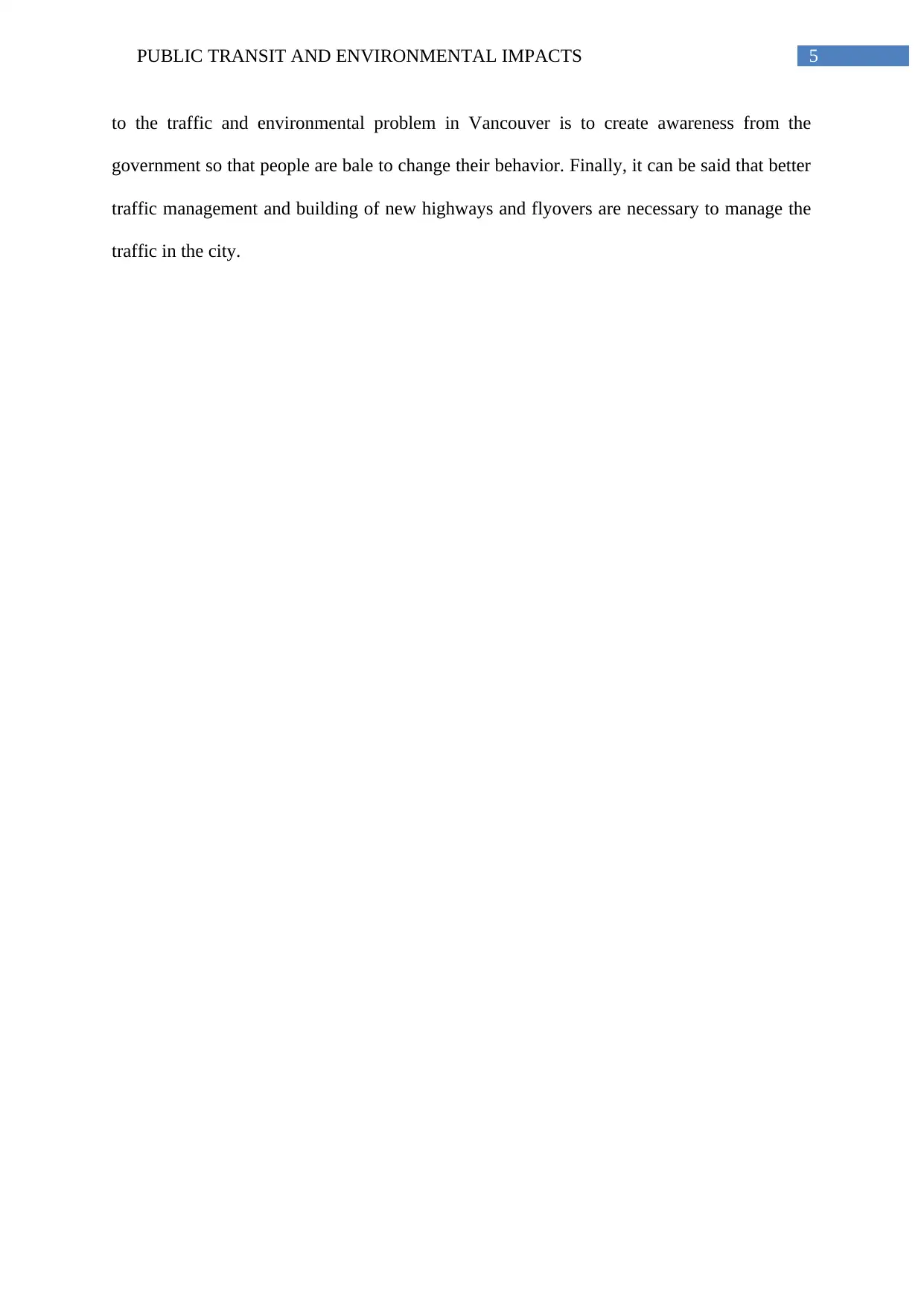
5PUBLIC TRANSIT AND ENVIRONMENTAL IMPACTS
to the traffic and environmental problem in Vancouver is to create awareness from the
government so that people are bale to change their behavior. Finally, it can be said that better
traffic management and building of new highways and flyovers are necessary to manage the
traffic in the city.
to the traffic and environmental problem in Vancouver is to create awareness from the
government so that people are bale to change their behavior. Finally, it can be said that better
traffic management and building of new highways and flyovers are necessary to manage the
traffic in the city.
⊘ This is a preview!⊘
Do you want full access?
Subscribe today to unlock all pages.

Trusted by 1+ million students worldwide
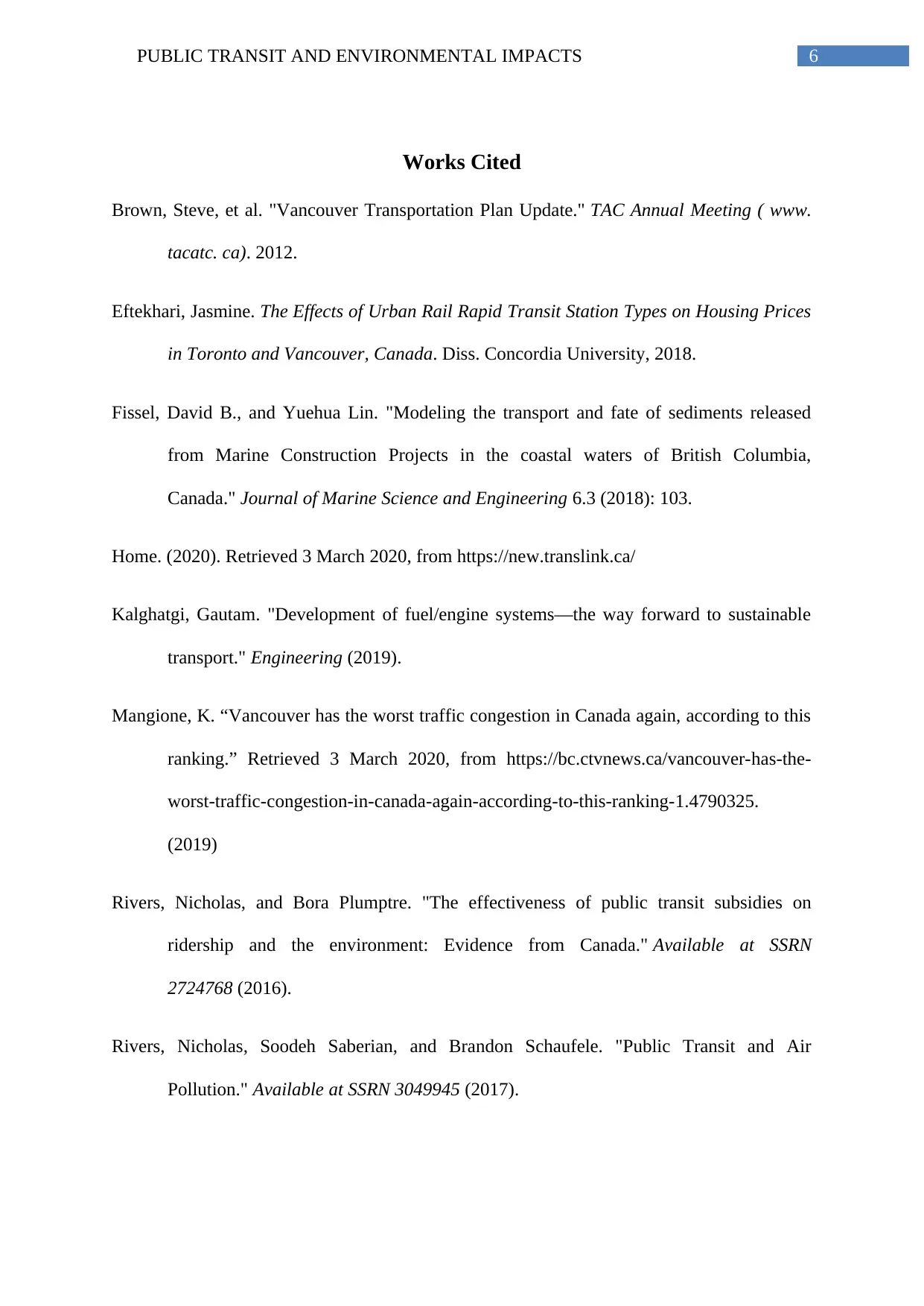
6PUBLIC TRANSIT AND ENVIRONMENTAL IMPACTS
Works Cited
Brown, Steve, et al. "Vancouver Transportation Plan Update." TAC Annual Meeting ( www.
tacatc. ca). 2012.
Eftekhari, Jasmine. The Effects of Urban Rail Rapid Transit Station Types on Housing Prices
in Toronto and Vancouver, Canada. Diss. Concordia University, 2018.
Fissel, David B., and Yuehua Lin. "Modeling the transport and fate of sediments released
from Marine Construction Projects in the coastal waters of British Columbia,
Canada." Journal of Marine Science and Engineering 6.3 (2018): 103.
Home. (2020). Retrieved 3 March 2020, from https://new.translink.ca/
Kalghatgi, Gautam. "Development of fuel/engine systems—the way forward to sustainable
transport." Engineering (2019).
Mangione, K. “Vancouver has the worst traffic congestion in Canada again, according to this
ranking.” Retrieved 3 March 2020, from https://bc.ctvnews.ca/vancouver-has-the-
worst-traffic-congestion-in-canada-again-according-to-this-ranking-1.4790325.
(2019)
Rivers, Nicholas, and Bora Plumptre. "The effectiveness of public transit subsidies on
ridership and the environment: Evidence from Canada." Available at SSRN
2724768 (2016).
Rivers, Nicholas, Soodeh Saberian, and Brandon Schaufele. "Public Transit and Air
Pollution." Available at SSRN 3049945 (2017).
Works Cited
Brown, Steve, et al. "Vancouver Transportation Plan Update." TAC Annual Meeting ( www.
tacatc. ca). 2012.
Eftekhari, Jasmine. The Effects of Urban Rail Rapid Transit Station Types on Housing Prices
in Toronto and Vancouver, Canada. Diss. Concordia University, 2018.
Fissel, David B., and Yuehua Lin. "Modeling the transport and fate of sediments released
from Marine Construction Projects in the coastal waters of British Columbia,
Canada." Journal of Marine Science and Engineering 6.3 (2018): 103.
Home. (2020). Retrieved 3 March 2020, from https://new.translink.ca/
Kalghatgi, Gautam. "Development of fuel/engine systems—the way forward to sustainable
transport." Engineering (2019).
Mangione, K. “Vancouver has the worst traffic congestion in Canada again, according to this
ranking.” Retrieved 3 March 2020, from https://bc.ctvnews.ca/vancouver-has-the-
worst-traffic-congestion-in-canada-again-according-to-this-ranking-1.4790325.
(2019)
Rivers, Nicholas, and Bora Plumptre. "The effectiveness of public transit subsidies on
ridership and the environment: Evidence from Canada." Available at SSRN
2724768 (2016).
Rivers, Nicholas, Soodeh Saberian, and Brandon Schaufele. "Public Transit and Air
Pollution." Available at SSRN 3049945 (2017).
Paraphrase This Document
Need a fresh take? Get an instant paraphrase of this document with our AI Paraphraser
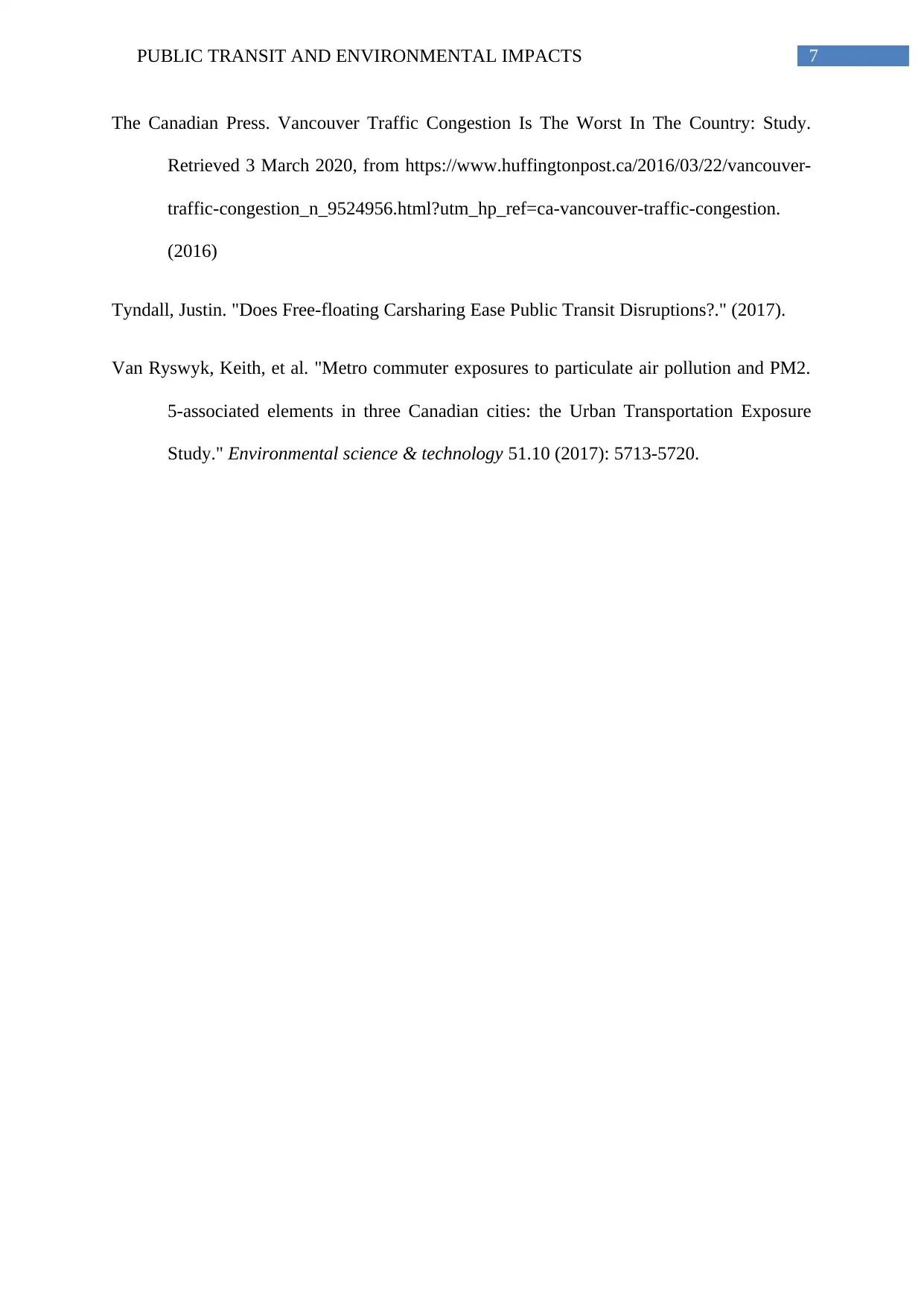
7PUBLIC TRANSIT AND ENVIRONMENTAL IMPACTS
The Canadian Press. Vancouver Traffic Congestion Is The Worst In The Country: Study.
Retrieved 3 March 2020, from https://www.huffingtonpost.ca/2016/03/22/vancouver-
traffic-congestion_n_9524956.html?utm_hp_ref=ca-vancouver-traffic-congestion.
(2016)
Tyndall, Justin. "Does Free-floating Carsharing Ease Public Transit Disruptions?." (2017).
Van Ryswyk, Keith, et al. "Metro commuter exposures to particulate air pollution and PM2.
5-associated elements in three Canadian cities: the Urban Transportation Exposure
Study." Environmental science & technology 51.10 (2017): 5713-5720.
The Canadian Press. Vancouver Traffic Congestion Is The Worst In The Country: Study.
Retrieved 3 March 2020, from https://www.huffingtonpost.ca/2016/03/22/vancouver-
traffic-congestion_n_9524956.html?utm_hp_ref=ca-vancouver-traffic-congestion.
(2016)
Tyndall, Justin. "Does Free-floating Carsharing Ease Public Transit Disruptions?." (2017).
Van Ryswyk, Keith, et al. "Metro commuter exposures to particulate air pollution and PM2.
5-associated elements in three Canadian cities: the Urban Transportation Exposure
Study." Environmental science & technology 51.10 (2017): 5713-5720.
1 out of 8
Related Documents
Your All-in-One AI-Powered Toolkit for Academic Success.
+13062052269
info@desklib.com
Available 24*7 on WhatsApp / Email
![[object Object]](/_next/static/media/star-bottom.7253800d.svg)
Unlock your academic potential
Copyright © 2020–2025 A2Z Services. All Rights Reserved. Developed and managed by ZUCOL.





